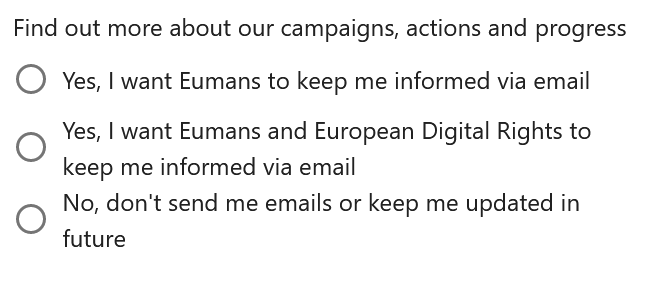Coalition Campaigns and Types of Partners
Part of what makes Proca special is the way we run Coalition Campaigns. Proca allows for a digital campaign action – petition signature collection, mail to target, etc – to be easily combined with supporter sign-up. It also allows for a common action to be taken by different organisations who collect supporter sign-ups separately. For more about how coalition campaigns work for GDPR and separate data collection, check out this blog post.
In this blog post we’re going to look at different types of coalitions and partners. Of course, there are many different ways of doing things, so we’re only going to cover the main options instead of every possible combination!
Coalition Campaigns
There are two benefits of coalitions:
- The action taken is common, so having a coalition expands the reach of the campaign and the number of people taking the action. There are many situations where this is useful, such as campaigns covering more than one country or language, or when a big issue is made up of lots of smaller issues.
- Supporter sign-up data is usually collected by both the lead organisation and partner organisations, giving more opportunities for everyone involved to grow their supporter base.
Lead Generation through Partners
Different configurations are possible! This is the most common one used in coalition campaigns on Proca: partner organisations have dual/split consent. This is typically used either if the lead organisation is leading on the campaign, or if they are an umbrella organisation who run a network, or if their is a campaign group set up specifically for the campaign. This approach gives a supporter the options to:
- Sign up to the Lead Organisation and the Partner Organisation
- Sign up to the Partner Organisation only
- Don’t sign up, I don’t want to be contacted
In a widget, it would look something like this (the text can be edited by the users!):

Of course, other options are available too, such as each organisation only collecting data for themselves with a usual opt in/no thanks and not also generating leads for another organisation.
The supporter data is stored separately, only accessible by the organisation(s) which the supporter opted into. It is also possible — and we recommend it! — for supporter data to be encrypted at rest so that it also needs an encryption key.
Lead and Partners
Most of the campaigns we have worked on so far have one lead organisation that has a load of other organisations join as partners. Usually the lead organisation pays and does the work of setting it up, and then partners are involved to increase the reach of the campaign towards a common goal, and are also able to collect supporter sign-ups.
This has the advantage, which I’m sure many experienced campaigners will recognise, that it is clear who is making the decisions, instead of bouncing ideas around a group with more than a few people in it.
One-Off Campaign Group
For some campaigns, a specific committee or working group is set up to run a campaign which is joint between different organisations. This campaign group would usually run its own newsletter and social media, which would be boosted by the member organisations. It might have five people from five different organisations jointly making decisions and running the campaign.
In this case, this campaign group would be the ‘lead organisation’ (even if it is not technically a separate entity), and each organisation would be involved as a partner.
Coalition of Equals
It would also be possible for there to be a coalition of equals, in which every organisation is involved in the set-up, paying for it and collect sign-up data equally. It is completely possible to have multiple Proca Widgets which have a common action but are distinct widgets for distinct organisations with separate supporter data collection.
Within a Stratified Coalition
Lead Organisation
Usually, a coalition campaign has a lead organisation. They do the main body of work for the campaign, make the decisions, collect supporter data and, usually, pay for it.
The lead organisation benefits because they are running the campaign, getting supporters to take actions and collecting sign-up data!
Partners
Partners who join the campaign benefit by:
- Contributing to the campaign by getting their supporters to take the action;
- Being part of the success of the campaign, both for the actions and the narrative;
- Collecting supporter sign-up data.
Different Types of Partners
A: Full partner. This partner has their own widget which takes the coalition and collects supporter data with a dual/split consent option.
B: Booster with own Widget. This partner has their own widget, which they can brand and put on their website, but does not themselves collect supporter data. The Widget would be a dressed-up copy of the lead organisation’s widget. This also makes it easy to track where actions are being taken by both the partner and the lead organisation.
C: Booster with campaign widget. This partner puts a Proca campaign widget on their own website without any customisation or supporter data collection. It is very easy for the partner to do as it only involves pasting some code on their website and they do not need a Proca account.
D: Signal boost only. This partner pushes the campaign on emails, social media, etc, to help the campaign have a broader reach, but does not put anything on their website or have any involvement with Proca.
